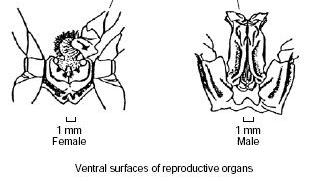Reproduction
Eastern King Prawn like most prawns have separate sexes (male,female). Adult females are larger than adult males(refer to size section).
Males have a large copulatory organ on their ventral side called a Petasma found between their front swimming legs (Below right) (Montgomery 2010).
Females have a structure on their ventral side called a thelycum. This provides a site for the males spermatophore(sperm packet)(Below left)(Montgomery 2010). once fertilized the female can spawn when she is ready. One female can carry as many as 200 000 eggs, larger females can carry more eggs than smaller females (The Department of Industry and Investment NSW 2010).
| |
 |
|
| |
Figure 6: Reproductive organs of Eastern King Prawn. (original image modified from The Department of Industry and Investment 2010) |
|
|